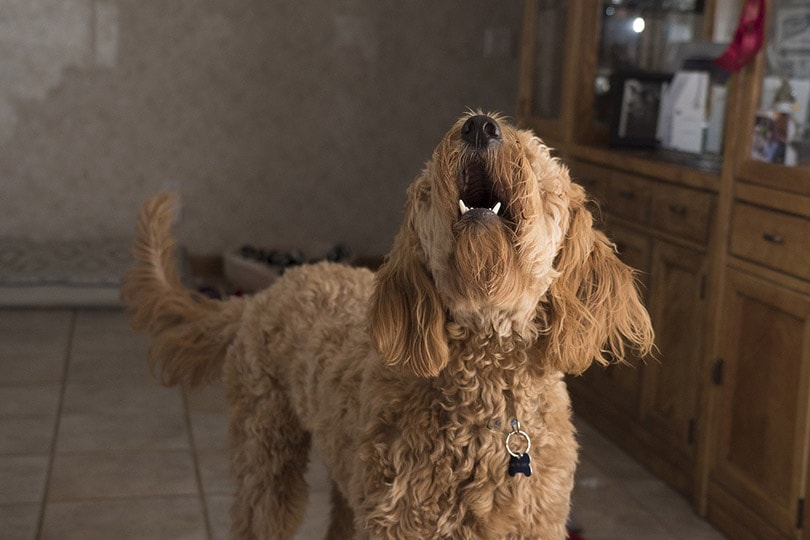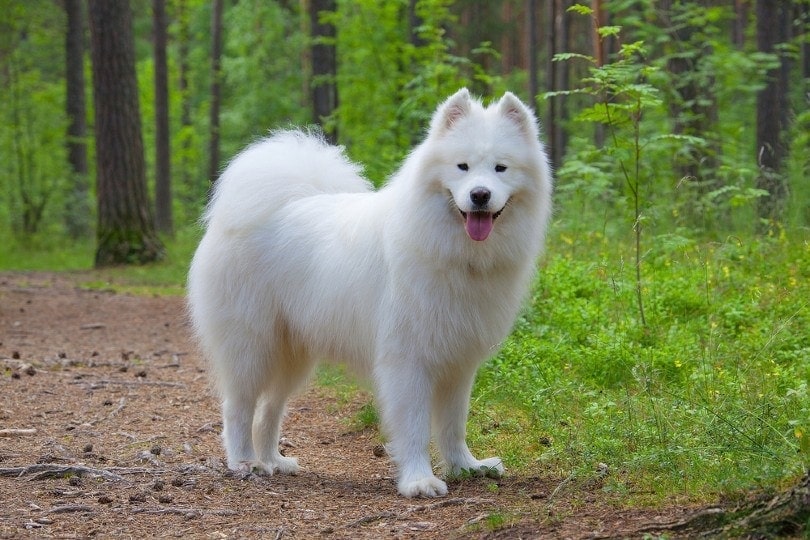Why Does My Dog Bark at the Wall? 5 Vet Reviewed Reasons & What to Do
By Lorre Luther
Updated on

If you have a dog, chances are you’ve seen them bark at a wall without reason. You might have been concerned the first time it happened, but by now, you’re probably just wondering why. Why would your perfectly healthy, reasonable canine companion spend their time barking at a blank wall?
Believe it or not, no one can explain what motivates your dog to bark at walls. Instead, several reasons could be behind your pup’s behavior. But rest assured, the most likely cause is that they heard or saw something you can’t discern. Below, we’ll discuss the five most likely reasons your four-footed friend sometimes gets crazy and starts barking at walls.
1. Your Dog Actually Hears Something
Dogs have sensitive hearing and can hear sounds at volumes and pitches that humans simply can’t. Unlike humans, canines can hear sounds with frequencies between 3,000 and 12,000 Hz. Decibels measure a sound’s loudness, with 0 being the starting point for humans’ hearing ability. Dogs can hear sounds between 3,000 and 12,000Hz at volumes as low as -15dB, which is quite a feat.
Once sounds reach frequencies higher than 12,000Hz, it’s best to give the prize to your canine companion and move on. Humans can’t hear at all once you get past frequencies around 20,000Hz. Yet your furry four-footer can hear sounds at frequencies as high as 65,000Hz.
So, if your pet suddenly begins barking at the wall, there’s a good chance they heard something you didn’t hear, probably because your ears aren’t sensitive enough.

2. Your Dog Sees Something
Dogs can also see much better than their human companions in some situations, particularly when the lighting is low. Your four-legged friend’s low-light vision is at least five times better than yours! They have large pupils, allowing more light to hit their optical nerves. Canine retinas are packed full of rods; the more retinal rods an animal has, the better their ability to see in low light.
Even more important to your dog’s night vision is the tapetum, which reflects light after it enters the eye and enhances their night vision by allowing even more light to hit their retina. It’s also the reason your dog’s eyes look luminescent at night! If your dog is barking at a wall and the light in your room is dim, they could have seen an insect or shadow imperceptible to your eyes.
3. Your Dog Is Suffering from Cognitive Dysfunction
As your companion enters their senior years, they’ll likely experience a few changes. Many active pups become more sedentary, enjoying long snoozes more than playing fetch all afternoon due to conditions such as arthritis. Unfortunately, some also suffer from cognitive decline as they age, which can lead to excessive barking, becoming disoriented in familiar surroundings, and restlessness. The condition is technically called Canine Cognitive Dysfunction (CCD).
Although veterinarians aren’t exactly sure what causes CCD, they suspect it’s most likely linked to the atrophy of your dog’s brain cells. If your pup is young and otherwise healthy, there’s probably nothing to be worried about. However, if your older dog starts exhibiting these behavioral changes, it’s time to speak to your veterinarian. They will likely run a series of blood tests and physically examine your dog.

4. Your Dog Is Engaging in Compulsive Behavior
Some dogs develop Canine Compulsive Disorder (CCD), in which normal activities, like barking, become unregulated to the point that they cannot stop the activity. Some breeds, including Doberman Pinschers and German Shepherds, are at heightened risk of developing CCD. Veterinarians believe the condition is linked to a serotonin imbalance, much like depression and obsessive-compulsive disorder in humans.
Compulsive behavior is also linked to anxiety and boredom. Dogs require a great deal of stimulation, and not enough toys, walks, and playtime can result in an anxious pet who engages in destructive behaviors to entertain and soothe themselves.
Giving your companion extra time and attention works wonders in minimizing compulsive behaviors. If your veterinarian thinks it appropriate, your dog can always take medication to limit the impact of the disease on their daily functioning and happiness.
5. Your Dog Is Seeking Attention
Some dogs resort to destructive and annoying behaviors when they want your attention, such as shoe stealing and destruction, tearing up furniture, and barking at walls. In those cases, their behavior really is about eliciting a response from you. Owners usually see their pets engage in these tactics when they’re bored or not getting enough exercise. Or, you might also need to pay more attention to your companion.
The most effective way to prevent attention-seeking behavior is to ignore it; don’t respond when your dog begins barking incessantly at the wall. Give extra pats and treats when your dog manages to reign in their behavior, and consider doggy daycare if your pup stays home for long periods alone to increase their stimulation by exposing them to other dogs and environments.

Conclusion
While barking at walls is not always a serious issue, it’s best to speak to your veterinarian if you’re concerned about the depth and intensity of your pet’s behavior or if you see other behavioral changes happening simultaneously, particularly if you have a senior pet. Dogs have odd habits, but luckily, barking at walls is one of the least concerning.
Featured Image Credit: dahancoo, Pixabay












